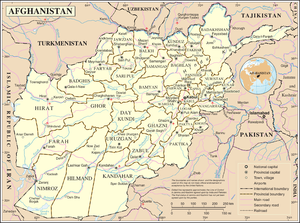Operation Omari
| Operation Omari | |||||||
|---|---|---|---|---|---|---|---|
| Part of the War in Afghanistan (2001–2021), Taliban insurgency | |||||||
 | |||||||
| |||||||
| Belligerents | |||||||
|
|
| ||||||
Operation Omari, also called the Spring Offensive, was an offensive launched by the Taliban against the Afghan government in Afghanistan. Its start was announced on 12 April 2016.[1][2] The Taliban made their yearly spring offensive announcement on April 12, 2016. They named the offensive in honor of the movement's late leader. The announcement of Operation Omari includes details on how the members of the group should present themselves in public. The aim of the Operation is considered ambitious and its focus is on clearing the remaining areas from enemy control and presence.[3] Unlike offensive announcements from previous years this announcement contained details about specific targets that would be attacked during the operation. The targets were stated in general terms with reference only to "large scale attacks on enemy positions across the country, martyrdom-seeking and tactical attacks against enemy strongholds, and assassination of enemy commanders in urban centers."[3]
Etymology
[edit]The name of the operation was named after Taliban founder and leader Mohammed Omar.
Timeline
[edit]2016
[edit]April
[edit]May
[edit]This section needs expansion. You can help by adding to it. (February 2017) |
June
[edit]In late June 2016, IS militants attacked police checkpoints in the Kot area of Nangarhar province, heavy fighting between Islamic State militants and government security forces has claimed dozens of lives in eastern Afghanistan, as many as 36 IS militants are reported to have been killed in the assaults, at least a dozen Afghan security forces and civilians have been killed, with another 18 wounded. The latest attacks indicate the group remains a potent threat to a government already battling an insurgency dominated by the rival Taliban.[4][5]
July
[edit]August
[edit]1 August 2016 Kabul attack, the Jani Khel offensive begins on 10 August.
September
[edit]On 5 September, 80 Taliban militants were killed and 100 others injured after hundreds of fighters launched a coordinated offensive to capture Giro District, Ghazni Province. Five security personnel also had been killed and eight others injured during the operation.[citation needed] The Jani Khel offensive ends in an Afghan government victory; the September 2016 Kabul bombing takes place.
Between 7–11 September, Battle of Tarinkot (2016) takes place, resulting in an Afghan government victory.
On 8 September, 79 insurgents had been killed in Tarin Kot, Urozgan Province. Taliban said they broke into Tarin Kot's prison, but Samim rejected the claim and said many of the inmates had been transferred to the airport.[6]
See also
[edit]References
[edit]- ^ James Mackenzie (12 April 2016). "Taliban announce start of spring offensive in Afghanistan". Reuters.
- ^ "Taliban Launches Anti-Government Spring Offensive". VOA.
- ^ a b Osman, Borhan (April 14, 2016). "Operation Omari: Taleban Announced 2016 Spring Offensive". Afghanistan Analysts Network. Archived from the original on 2013-08-12.
- ^ "Dozens killed as Islamic State pushes for territory in Afghanistan". the telegraph. 26 June 2016.
- ^ "Islamic State militants launch new attacks in eastern Afghanistan". Reuters. 2016-06-26. Retrieved 2016-06-26.
- ^ "Taliban storm into southern Afghan city". AFP. 7 September 2016.
